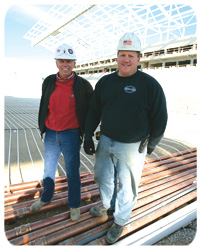
A couple of years ago, we wrote a cover story asking the question, “Is there anything radiant can't do?” The word “heating” was implied, but maybe “tubing” would do just as well.
Take, for example, the 27 miles of radiant tubing buried underneath a new soccer stadium in Chicago, the new home to Major League Soccer team the Chicago Fire.
It doesn't warm the players' feet any, since it's buried too far underneath the surface. It doesn't melt the snow and ice of a Chicago winter. (Not that you'd play soccer in a blizzard, but if you were to walk on the surface in a typical cold Chicago January, you'd still hear the crunch of the icy surface breaking under your feet.) And while radiant systems are known for low-temperature water, this one is designed to run a glycol mixture at just 62 degrees F.
What it does do a miraculous job at is help the grass grow.
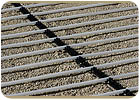
The intent is to warm the root zone beneath the grass, so that the playing surface remains soft and forgiving to athletic joints. It makes perfect sense for colder weather sports, and many new open-air football stadiums have a warm, water-and-glycol mixture circulating through buried tubing.
But the tubing can also be found under warmer venues, such as golf courses. In this case, the tubing only goes under the more fragile greens, a great example of how the term “turf conditioning” really applies.
Turf conditioning is nothing new to Bennett. An Althoff crew finished up the Chicago Fire stadium job last year, but the company put a similar system in Soldier Field, home to the Chicago Bears, during an extensive renovation of the site in 2003-2004. In fact, Bennett supervised both projects as well as assisted his firm's initial foray into turf conditioning under the Bears' suburban practice field seven years before the Solider Field job.
“We want to be the 'go to' company for many different types of jobs,” Bennett adds. “We certainly do plenty of basic work, but we like to do something different. With turf conditioning work, we do have a lot of business that 'goes to' us.”
One way any contractor can earn this reputation is by finding ways to make the job safer for its crew and faster to complete for the customer. It often means a bigger-than-expected job for the contractor. The Bridgeview Stadium, for example, was originally designed to cover just half the field.
The finished job, however, stretched end zone to end zone - thanks, in part, to a souped-up kid's snow sled no less.
Sports Construction Group, the Cleveland-based contractor responsible for building the playing surface at Bridgeview, began the installation process in early November 2005 by laying a 4-inch foundation made of pea gravel. This type of earth moving has to be precise, with the grading process guided by lasers so the finished surface is perfectly flat.
As a result, Althoff's 10-man installation crew was not permitted to step onto the gravel while installing the PEX loops.
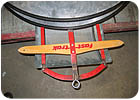
The Uponor (Wirsbo) hePEX™ plus tubing was looped around the spool: one end was held at the copper manifold; the other, to a reel holding the rest of the 850-ft. PEX coil. The sled ran atop numerous 4-ft. x 6-ft. Masonite sheets that were laid end to end across the field. (The crew could walk across the surface this way since the sheets evenly distributed their weight. The “no walking” amounted to “no stepping.”)

The rail system is a major upgrade over an older method of securing the tubing to the field.
“Before the rail system, the crew had to tie PEX down to mesh,” Bennett explains. “I don't care how well-conditioned a guy is, you're bound to have a back problem bending down all day long like that.” Plus, it's all too easy to trip on the mesh.
“We want to beat the schedule, but do so safely,” Bennett says. “We've got great crews and if we were to lose one guy for three months, we might spend just as long trying to find someone to fill in. With the railing system, we move more quickly with no bending, so no one gets hurt.”
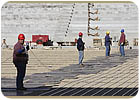
Like the interior of a home, the field is segmented into four heating zones, also running the length of the field from goal to goal. Each zone contains 42 PEX loops and two temperature sensors that sit within underground boxes connected to one another with plastic conduit.
On sunny days, the demand for warmth varies from zone to zone, depending on the position of the sun. The sensors in each zone communicate an average demand back to a series of control valves, which modulate the flow of warm water in response. The objective is to keep the root system at a consistently comfortable 62 degrees F.
“The field is warm and moist enough that it can actually grow grass in December or even January,” he remarks.
But what happens if any of the underground sensors ever need to be repaired? All eight are on a GPS, according to Bennett, enabling service personnel to pinpoint the positions of the underground boxes to within 18 inches. “We also provide a complete photo log of the boxes' installation, which should also help in locating them,” he says.
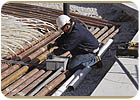
“It is a closed, reverse-return system that is self-balancing,” Althoff's Bennett explains. “The first half of each loop functions the supply line, moving the fluid from the copper manifold at the south end to the far north end of the field. The return line brings the solution back to that manifold, which then moves it to the boilers underneath the stands for reheating and recirculation.”
The only connections are at the copper manifolds, positioned at the south end of the field, where each PEX loop begins and ends - thus removing potential service issues to outside the playing area. The copper headers are fitted with stubouts at the factory for making the PEX connections, saving substantial time on the jobsite.
A pair of commercial-grade, 150-horsepower boilers, situated in a mechanical room under the concrete stands on the east side of the field, feed the 50 percent-glycol solution through two heat exchangers and 1,400 ft. of 4-inch copper supply-and-return piping, on their way to roughly 400 ft. of manifold. Because so much of it is encased in concrete under the stands, the copper portion of the system had to be thoroughly tested at high pressures even before the PEX tubing was completely installed on the field.
Bridgeview Stadium: Home Of The Chicago Fire
We put the finishing touches to this story just weeks before the Chicago Fire was to play its first home game at its new home, Bridgeview Stadium, in late-June. The $70 million, 20,000-seat stadium is the fourth stadium built in this country specifically for soccer. Depending on how well the Major League Soccer team does, the Fire's season could stretch into mid-November. There also are plans for local high school football teams to make use of the field as well in the fall.Before this year, the Fire played its first four seasons at Soldier Field, home of the Chicago Bears, then a local community college's stadium when the Bears revamped its stadium, and then back to the new-and-improved Soldier Field in 2003. One of the improvements to Soldier Field was a turf-conditioning system.
Bennett reports that the Bridgeview Stadium turf- conditioning installation ultimately went well due in part to having the same field team, led by John Lavin and Jay Althoff. The entire tubing system was firmly in place after only five days.
“Speed - getting the tubing down quickly and properly - is a premium value on a job like this,” says Bennett. Because of rains in October, the crew's startup was delayed by a week and a half. “Once we finally had an opening in the weather, we had to get the job done before it turned bad again and we found ourselves working in a mud hole.”
The spectacle of 10 grown men chasing a kid's sled up and down a soccer field, as it spins a web of plastic tubing from end to end, is bound to attract attention. “All the other trades have a tendency to stop and watch us,” says Bennett, “and that's really kinda cool. At Althoff, we get involved in all sorts of construction projects, but a job like this one or the one at Soldier Field gives our guys a little break from the norm, and they get excited about that.”
Only two days after the Althoff crew finished, the PEX tubing was buried in a 10-inch mix of sand and peat moss followed by 1 5/8 inches of premium Kentucky bluegrass sod.
The turf-conditioning system isn't the only mechanical feature done for the playing surface. Althoff also helped install a special drainage system that uses blowers to draw rainwater through the grass and dirt and down the storm sewer. Afterward, the blowers are reversed and the air helps dry the field.